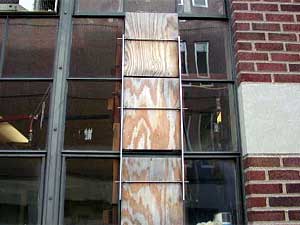|
Photos
More from MPR
|
 |
| The University of Minnesota wants to replace windows at the Mechanical Engineering building (MPR Photo/Art Hughes) |
St. Paul, Minn. — Gleaming, state-of-the-art buildings are visible beacons of progress elected officials and university administrators can easily point to. Once the buildings are up, however, they become one of many structures requiring ongoing maintenance.
Kathleen O'Brien surveys one pressing repair project at the 1948 Mechanical Engineering Building at the University of Minnesota. O'Brien is vice president of university services.
"Here's a good view of Mechanical Engineering and its windows," she said. "You'll notice it's got pipes sticking out and window air conditioners; not exactly high tech for a high-tech discipline is it?"
Replacing the aging metal-frame windows that stretch along one full wing of the building is estimated to cost $1.8 million. It's one of many on the U of M's list that totals $80 million. O'Brien says such projects, replacing old boilers, repairing leaky roofs and shoring up crumbling foundations are costly but necessary and typically fly under the radar of elected leaders.
"So when we look at building systems like roofs and windows, stone and brick tuck pointing, we're really talking about stabilizing the exterior of the structure and the integrity of the building so we don't get deterioration and premature aging of the structure," O'Brien said.
Paint peels from rust spots on an adjacent building. That project is not on the list, O'Brien said, because the damage doesn't undermine the structure, even if it is unsightly.
The maintenance projects for the University of Minnesota and MnSCU fall under a category known as HEAPR -- Higher Education Asset Preservation and Replacement. It's a system started in the '90s to set aside money specifically for basic repairs to address the list of building upkeep projects that far outpace the university systems' ability to pay for them. But the allocation from the state typically falls well short of what's requested.
In the last session legislators rewarded the U of M its full request for new construction, but cut more than half of the maintenance dollars. University financial officer Richard Pfutzenreuter said officials realize it's an easy target for cuts.
"It's very often the one that gets cut back in lieu of funding projects that are needed, but they tend to reduce the HEAPR request and fund individual projects," Pfutzenreuter said. "New buildings have more cachet than some of the stuff out of sight going on behind the walls."
Pfutzenreuter acknowledges the $80 million request will be a tough sell at the Legislature. Both the U of M and MnSCU have brought legislators along on tours of their facilities to highlight the need for improvements. In one inadvertently effective presentation at Winona State University, a small legislative delegation got stranded in a faulty elevator for 20 minutes.
But Rep. Alice Hausman, DFL-St. Paul, pointed out the need for state money comes from many different directions.
"When we have a bonding bill for $700 million and requests for $3 billion, we say 'no' to a lot of it," Hausman said. "When there is a big line item, like $80 million for HEAPR on the University of Minnesota campus, it's just so tempting to take $10 million out of that if we need it for the Schubert Theatre in Minneapolis or the Lake of the Isles, or a similar project."
Hausman is a member of the House Capital Investment Committee.
Another legislator, Denny McNamara, R-Hastings, who is vice-chair of the same committee, suggested this could be a better year for university repairs.
"Maybe last time in the need to do so many projects we didn't fund HEAPR to the level that we could have or there just wasn't enough money to go around, "McNamara said. "This year I think you're going to see the HEAPR raise to the top more and there may be less projects funded but more money to HEAPR."
The projection of a state budget surplus is a promising sign for the MnSCU and U of M requests. But there are potential pitfalls to consider as well. One such complication is the push for a new University of Minnesota football stadium. Although university officials still hold out hope, a special session to consider the stadium funding appears unlikely. Some legislators think the stadium idea during the regular legislative session could compete with the rest of the university's wish list.






